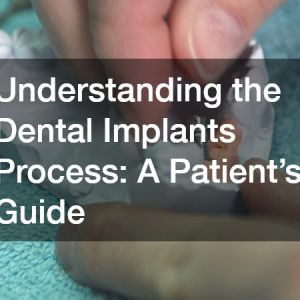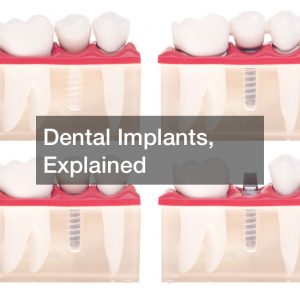What Are the Most Common Procedures a Restorative Dentist Can Provide?
Restorative dentistry is vital for preserving oral health, restoring function, and enhancing aesthetics. It focuses on repairing or replacing damaged, decayed, or missing teeth to help patients regain a confident, healthy smile.
Below is an overview of the most common restorative dental procedures and their significance.
What Is Restorative Dentistry?
Restorative dentistry involves the diagnosis, prevention, and treatment of oral diseases that affect the structure and function of the teeth. Its primary goal is to restore the mouth’s normal function while improving appearance and comfort.
While restorative dentistry and cosmetic dentistry often overlap, their objectives differ. Cosmetic dentistry emphasizes aesthetics, such as whitening and veneers, while restorative dentistry focuses on repairing or replacing teeth for better function and health. Many treatments, like crowns or fillings, serve both purposes.
Common issues treated through restorative dentistry include cavities, cracked or broken teeth, tooth loss, and enamel wear. Addressing these problems early can prevent more complex dental issues in the future.
The importance of restorative dentistry lies in its ability to preserve natural teeth, prevent further decay, and maintain proper chewing and speaking functions. It also contributes to overall health, as oral infections can affect other areas of the body.
Ideal candidates for restorative dentistry include patients with decayed, damaged, or missing teeth, as well as those seeking to improve the durability and functionality of their bite.
What Are Dental Fillings and When Are They Used?
Dental fillings are one of the most common restorative treatments. They are used to repair minor tooth decay or small fractures, preventing further damage and restoring the tooth’s natural shape.
Different types of materials can be used for fillings, including amalgam (silver), composite resin (tooth-colored), gold, and ceramic. The choice of material depends on the location of the tooth, aesthetic preference, and budget.
During the procedure, the dentist removes the decayed portion of the tooth, cleans the affected area, and fills it with the chosen material. The filling is then shaped and polished to ensure a natural look and proper bite alignment.
Fillings help restore tooth integrity, prevent further decay, and maintain normal chewing function. With proper care, such as regular brushing, flossing, and dental checkups, they can last many years.
Potential complications may include sensitivity or wear over time, but these can typically be managed with proper oral hygiene and timely replacements.
How Can Dental Crowns Help Restore Teeth?
Dental crowns are protective caps that cover and restore damaged or weakened teeth. They are often used when a filling is not sufficient to restore a tooth’s structure or after a root canal procedure.
Crowns can be made from materials such as metal, porcelain-fused-to-metal, all-ceramic, or zirconia. The material choice depends on durability needs and aesthetic considerations.
Dentists may recommend crowns for teeth with large cavities, fractures, or after extensive restorative work. They not only protect the tooth but also improve its appearance and function.
The crown placement process involves reshaping the tooth, taking an impression, and fitting a temporary crown while the permanent one is crafted. Once ready, the final crown is cemented securely in place.
Maintaining crowns requires good oral hygiene, avoiding excessively hard foods, and attending regular dental visits to ensure longevity and comfort.
What Is the Role of Root Canal Treatment in Dentistry?
Root canal therapy is a restorative procedure designed to save a severely infected or damaged tooth. It eliminates bacteria from the infected root canal, prevents reinfection, and preserves the natural tooth.
Signs that a root canal may be needed include persistent tooth pain, sensitivity to temperature, gum swelling, and darkening of the tooth.
During the procedure, the dentist removes the infected pulp, cleans and disinfects the inner canal, and seals it with a biocompatible material. A crown is often placed afterward to protect and strengthen the tooth.
Many misconceptions exist about root canals being painful, but modern techniques make the procedure virtually painless and highly effective.
After treatment, patients should maintain proper oral hygiene and avoid chewing on hard objects to ensure successful recovery and long-term stability.
Why Are Dental Bridges Important and How Do They Work?
Dental bridges are used to replace one or more missing teeth by anchoring artificial teeth to adjacent natural teeth or implants. They play a vital role in restoring bite balance, facial structure, and speech clarity.
There are several types of dental bridges, including traditional, cantilever, Maryland, and implant-supported bridges. The choice depends on the location of the missing tooth and the condition of the surrounding teeth.
Dentists often recommend bridges when a patient has lost a tooth but still has healthy adjacent teeth that can serve as supports.
The procedure involves reshaping the supporting teeth, taking impressions, and fabricating the bridge to fit precisely. Once ready, it is cemented into place for a secure, natural-looking result.
Bridges help prevent neighboring teeth from shifting, improve chewing function, and enhance appearance. Regular dental care, including flossing around the bridge and routine checkups, ensures long-term success.
Restorative dentistry is essential for maintaining healthy, functional, and attractive teeth. From fillings and crowns to root canals and bridges, these procedures not only restore oral health but also improve confidence and quality of life. Understanding the purpose and benefits of each treatment allows patients to make informed decisions about their dental care.

Related Posts

Understanding the Dental Implants Process A Patient’s Guide
Dental implants have become one of the most reliable and long-lasting solutions for replacing missing teeth. This guide explains what dental implants are, how they work, who qualifies…

How to Find the Best Dentist Near Me for Implants
Finding the right dental care provider is essential, especially when it comes to complex procedures like dental implants. The phrase “best dentist near me for implants” is a…

What Are Invisalign Braces
Invisalign braces are a modern orthodontic solution designed to straighten teeth discreetly and comfortably. Unlike traditional metal braces, Invisalign uses a series of clear, removable aligners made from…

Understanding Dental Implants Procedures
The video on dental implants makes a good case for choosing this option over other methods of replacing missing teeth. The technique offers several benefits over other tooth…

Dental Implants, Explained
Dental implants are artificial tooth roots surgically placed into the jawbone beneath the gums. They serve as a stable foundation for replacement teeth, such as crowns, bridges, or…

What is a Dental Crown?
A dental crown is a usual type of dental restoration covering a damaged or weakened tooth. It is designed to protect, strengthen, and enhance the appearance of a…
Copyright © All Rights Reserved | Uncovering the Dental Implant Process | Sitemap
